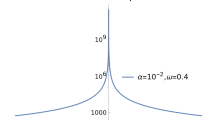Abstract
The linear relationship between the frequency of an EPR transition and the magnetic field, valid in the presence of only the Zeeman interaction, generally becomes nonlinear, when other interactions become operative. In such cases, obtaining accurate values of the resonance magnetic fields of a given spin system for simulating their EPR spectra, recorded at a fixed frequency, is not a trivial exercise. Because of its fundamental importance in the analysis of EPR spectra, there are several methods available in the literature to address this issue. These methods either use numerical techniques to compute the resonance fields from the resonance energies computed at various magnetic fields by diagonalization of the Hamiltonian matrix, or modify the Hamiltonian appropriately and resort to perturbation calculations. In this work, we have examined a method based on a mathematical technique of reversion of a power series, by which the resonance magnetic fields at a fixed frequency can be achieved in a relatively simple and straightforward manner. We have shown that, when the energy of an EPR transition can be expressed as a power series in powers of the magnetic field, obtained either from the analytical energy expression or by fitting the calculated energies to an empirical power series, a reversed power series in powers of the transition energy can be obtained to represent the resonance magnetic field. We have derived the necessary algebraic relationships between the coefficients of these two series. We have shown the success and usefulness of this method by applying it to calculate the resonance magnetic fields of well-studied EPR spectra of hydrogen atom, naphthalene triplet, and 6S state of Fe3+ in an octahedral crystalline electric field, at different frequencies.


Similar content being viewed by others
Notes
In mathematical literature, a power series generally means a series involving only positive powers, as in Eq. 1. When negative powers are included, as in Eqs. 5 or 6, the series is called a Laurent series. In this work, however, we do not distinguish between the two, and call both of them power series.
References
C.R. Byfleet, D.P. Chong, J.A. Hebden, C.A. McDowell, J. Magn. Reson. 2, 69 (1970)
G.G. Belford, R.L. Belford, J.F. Burkhalter, J. Magn. Reson. 11, 251 (1973)
K.T. McGregor, R.P. Scaringe, W.E. Hatfield, Mol. Phys. 30, 1925 (1975)
M.I. Scullane, L.K. White, N.D. Chasteen, J. Magn. Reson. 47, 383 (1982)
A.S. Yang, B.J. Gaffney, Biophys. J. 51, 55 (1987)
G.C.M. Gribnau, J.L.C. van Tits, E.J. Reijerse, J. Magn. Reson. 90, 474 (1990)
D. Nettar, J.J. Villafranca, J. Magn. Reson. 64, 61 (1985)
B.J. Gaffney, H.J. Silverstone, J. Magn. Reson. 134, 57 (1998)
D. Collison, F.E. Mabbs, J. Chem. Soc. Dalton Trans. 1565 (1982)
S. Stoll, A. Schweiger, Chem. Phys. Lett. 380, 464 (2003)
S. Stoll, Computational modeling and least-squares fitting of EPR spectra, in Multifrequency electron paramagnetic resonance: data and techniques, ed. by S.K. Misra (Wiley-VCH, Weinheim, 2014), pp. 69–138
J.O. Hirschfelder, W.B. Brown, S.T. Epstein, Recent developments in perturbation theory, in Advances in quantum chemistry, vol. 1, ed. by P.-O. Löwdin (Academic Press, New York, 1964), pp. 255–374
I. Mayer, Simple theorems, proofs, and derivations in quantum chemistry (Kluwer Academic/Plenum Publishers, New York, 2003), pp. 323–324
A. Rockenbauer, P. Simon, J. Magn. Reson. 11, 217 (1973)
M. Iwasaki, J. Magn. Reson. 16, 417 (1974)
Y. Teki, T. Takui, K. Itoh, J. Chem. Phys. 88, 6134 (1988)
Y. Teki, I. Fujita, T. Takui, T. Kinoshita, K. Itoh, J. Am. Chem. Soc. 116, 11499 (1994)
F.E. Mabbs, D. Collision, Electron paramagnetic resonance of d transition metal compounds (Elsevier, Amsterdam, 1992), p. 134
T. Yamane, K. Sugisaki, T. Nakagawa, H. Matsuoka, T. Nishio, S. Kinjyo, N. Mori, S. Yokoyama, C. Kawashima, N. Yokokura, K. Sato, Y. Kanzaki, D. Shiomi, K. Toyota, D.H. Dolphin, W.-C. Lin, C.A. McDowell, M. Tadokoroc, T. Takui, Phys. Chem. Chem. Phys. 19, 24769 (2017)
T. Yamane, K. Sugisaki, H. Matsuoka, K. Sato, K. Toyota, D. Shiomia, T. Takui, Dalton Trans. 47, 16429 (2018)
M. Abramowitz, I.A. Stegun (eds.), Handbook of mathematical functions with formulas, graphs and mathematical tables, 10th printing (National Bureau of Standards, Washington, DC, 1972), p. 16. (entry 3.6.25)
S.M. Selby (ed.), CRC standard mathematical tables, 18th edn. (The Chemical Rubber Company, Cleveland, 1970), p. 454
G.B. Arfken, H.J. Weber, Mathematical methods for physicists, 4th edn. (Prism Books, Bangalore, 1995), p. 326
H. Chernoff, Math. Comp. 2, 331 (1947)
J.A. Weil, J.R. Bolton, Electron paramagnetic resonance: elementary theory and practical applications, 2nd edn. (Wiley-Interscience, New Jersey, 2007)
C.A. Hutchison Jr., B.W. Mangum, J. Chem. Phys. 34, 908 (1961)
M.S. de Groot, J.H. van der Waals, Mol. Phys. 6, 545 (1963)
P. Debye, Ann. Phys. 32, 85 (1938)
R. de L. Kronig, C.J. Bouwkamp, Physica 6, 290 (1939)
J.E. Wertz, J.R. Bolton, Electron spin resonance: elementary theory and practical applications (McGraw-Hill, New York, 1972)
W.H. Press, S.A. Teukolsky, W.T. Vetterling, B.P. Flannery, Numerical recipes in C: the art of scientific computing, 2nd edn. (Cambridge University Press, Cambridge, 1992), pp. 671–675
M.F. González-Cardel, R. Díaz-Uribe, Rev. Mex. Fís. E 52, 163 (2006)
Author information
Authors and Affiliations
Corresponding author
Additional information
Publisher's Note
Springer Nature remains neutral with regard to jurisdictional claims in published maps and institutional affiliations.
Rights and permissions
About this article
Cite this article
Rane, V., Das, R. Computation of Resonance Magnetic Fields of CW-EPR Spectra by Reversion of Power Series. Appl Magn Reson 50, 1001–1023 (2019). https://doi.org/10.1007/s00723-019-01128-6
Received:
Revised:
Published:
Issue Date:
DOI: https://doi.org/10.1007/s00723-019-01128-6




